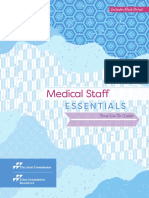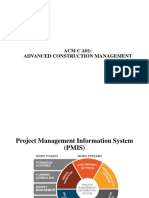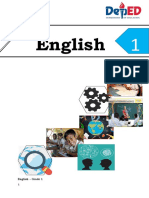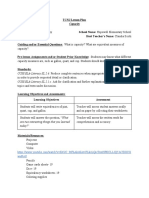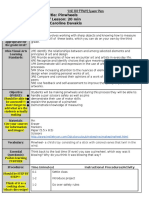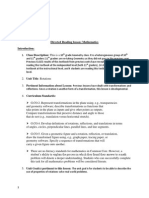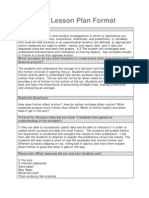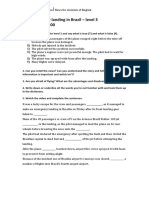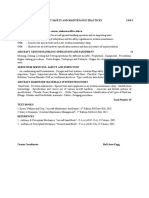EDUC 290-HACC Lesson Plan: Name: Title: Subject: Grade Level: Standard and Learning Goals Rationale
EDUC 290-HACC Lesson Plan: Name: Title: Subject: Grade Level: Standard and Learning Goals Rationale
Uploaded by
api-406114171Copyright:
Available Formats
EDUC 290-HACC Lesson Plan: Name: Title: Subject: Grade Level: Standard and Learning Goals Rationale
EDUC 290-HACC Lesson Plan: Name: Title: Subject: Grade Level: Standard and Learning Goals Rationale
Uploaded by
api-406114171Original Title
Copyright
Available Formats
Share this document
Did you find this document useful?
Is this content inappropriate?
Copyright:
Available Formats
EDUC 290-HACC Lesson Plan: Name: Title: Subject: Grade Level: Standard and Learning Goals Rationale
EDUC 290-HACC Lesson Plan: Name: Title: Subject: Grade Level: Standard and Learning Goals Rationale
Uploaded by
api-406114171Copyright:
Available Formats
Bryanna Fox
Language Lesson Plan
EDUC 270
EDUC 290- HACC Lesson plan
Name: Bryanna Fox Date: 4/3/2019
TITLE: Derby Distances!
SUBJECT: Math
GRADE LEVEL: Second Grade
STANDARD AND LEARNING GOALS:
RATIONALE: At this point in the class, students are very familiar with working with inches and feet.
They are able to define them and compare how they relate to one another (1:12). Looking at a distance
that is further than one foot and measuring it however will be new territory but I know that they will be
able to complete it due to their understanding of the concepts already.
ACTIVITY: First, the class will review feet and inches and how they relate to one another. Then, we will
use toy cars to measure coasting distance. Finally, we will review and compare results as a class.
STANDARD AND LEARNING GOALS:
STANDARD AREA:
Measurement, Data and Probability
STANDARD:
Standard - CC.2.4.2.A.5
Extend the concepts of addition and subtraction to problems involving length.
OBJECTIVE:
Students will use rulers to measure and record the coasting distance of racecars in feet and inches with
full completion and 80% accuracy.
CURRICULUM ALIGNMENT/CURRICULUM FRAMEWORK: (NAEYC 5c)
ESSENTIAL QUESTIONS:
- How can you measure lengths using customary units?
- Inches and feet
DURATION: 25 minutes
LIST OF MATERIALS/EQUIPMENT: (NAEYC 4.b)
● Cars Movie Clip - 2 min - https://www.youtube.com/watch?v=VaFiAt7aPBM
● A slabs of thick cardboard as a runway for each group (4)
● A roll of masking tape for each group (4)
● Rulers for each student
● A copy of the worksheet for each student
● Pencils
● No health or safety concerns
VOCABULARY: (NAEYC 4.b)
● Decline
● Accelerate
● Derby
PROCEDURES: (NAEYC 5c.)
1. I will begin this lesson by projecting a two minute clip from the movie Cars. This is a fun and
perhaps relatable clip to get children excited about the lesson today and seeing what we will do!
Meanwhile I will prepare the classroom for the activity.
2. After asking the students if they have ever watched a NASCAR race or even the movie Cars, I
will then unveil six different car toys.
3. I will explain that today we will be using what we know about inches and feet and measuring how
far each racecar will coast.
4. I will pull out a ruler and ask the class how long it is. “A foot!” When pointing at the small inch
section students will respond with “an inch!”.
5. I will ask for a student to remind the class how many inches are in a foot. 12!
6. “If I were measuring this library book which would I use? Inches or feet?” These questions will
just allow students to refresh on what they already know about inches and feet and prepare them
for the activity today.
7. I will hand out a worksheet for the activity so that they can fill it out cleanly and organized.
8. I will project a copy of the worksheet and describe how it will be used. As a class we will do the
first example together.
9. Using a slightly declining platform, I will rest the car on top and let it roll down the decline and
coast across the floor. I will clarify with the class that it is important to use a piece of tape and
mark off where the car stopped rolling. We will then use our rulers to figure out how far it
coasted!
10. Using rulers we will first discover how many whole feet the car coasted past. Then, seeing that
the space left is less than a foot, we can be sure that the inches will be less than 12. “3 ft 7 in.”
11. Once the demonstration is completed, I will project a premade list of small groups. The class will
be divided into 4 groups. Using the four runways around the classroom, students will coast all six
cars and measure their distances!
12. After the 15 minute timer is over, students will return to their desks and I will ask the class to
share their longest coasting distances and we will discuss which car coasted the best!
13. To close this activity I will ask the students to talk with their neighbor about which racecar they
would want to race in and why!
ASSESSMENT (Formative): (NAEYC 3.b)
● I will be collecting the worksheets and looking for total completion as well as at least 80%
accuracy. This means students must get just about five out of the six parts of their worksheet
correct.
EXTENSION:
● Students will be encouraged to find a couple toy cars at their own homes and race them! They can
then measure the distances just like we did in class. Parents are encouraged to snap a few pictures
so that I can include them in the monthly newsletter.
RELATED MATERIALS AND PROCEDURES:
● Book: Measuring Penny by Loreen Leedy
● Website: https://www.splashmath.com/measurement-games-for-2nd-graders
● App: Measure Length - Tiny Chicken
ADAPTATIONS:
● For any ELL students, I will include subtitles on the movie clip shown at the beginning of class.
They will also be put in groups with one other ELL student if at all possible to allow for more
comfortable discussion.
STUDENT REFLECTION: (NAEYC 4.d)
If I were a teacher I think I would really enjoy doing this lesson. I think that it is unique and fun!
Children will get excited about measuring which racecar coasts the furthest. Even though it really isn’t
anything competitive, it adds a bit of a game aspect and children will remember it! Concerning the writing
of the lesson plan, I think I did well in coming up with this idea and making it practical. I think this is
something a teacher could really do and it wouldn’t be unconventional. I would also be interested in
hearing suggestions of how to control the break out time and ensure students are on track. Since this
activity is engaging and there will be seperate groups, things could get lively. Assuming I wouldn’t have
an Aide to assist me, I would be very welcome to ideas of how to ensure there will be structure. Children
of all backgrounds and home lives will be able to connect with this lesson and would hopefully enjoy it!
Putting any ELL students together is one step I would take to ensure that they are comfortable and more
equip to contribute. According to Erikson’s theory, children in second grade really value developing a
sense of completion and competence. When they are able to view their work as purposeful and useful,
they connect and thrive. During this activity, students can see the relevance and uses of measurement as
well as gain confidence in their skill sets.
You might also like
- Diesel Fuel Receiving and Issuance Procedure100% (1)Diesel Fuel Receiving and Issuance Procedure4 pages
- A Detailed Lesson Plan in Science Parts of The Flower85% (20)A Detailed Lesson Plan in Science Parts of The Flower6 pages
- Drama Lesson Plans for Busy Teachers: Improvisation, Rhythm, Atmosphere: Drama Lesson Plans for Busy Teachers, #2From EverandDrama Lesson Plans for Busy Teachers: Improvisation, Rhythm, Atmosphere: Drama Lesson Plans for Busy Teachers, #2No ratings yet
- Assignment On Management Process and Organization Behavior72% (18)Assignment On Management Process and Organization Behavior48 pages
- Ready, Set, Teach Lesson Plan Format #3: StandardsNo ratings yetReady, Set, Teach Lesson Plan Format #3: Standards5 pages
- Whole-Y Cow Fractions Are Fun - First Grade Lesson100% (1)Whole-Y Cow Fractions Are Fun - First Grade Lesson3 pages
- Lesson Plan Foldable Perfect Tenses Jennifer Swain ANo ratings yetLesson Plan Foldable Perfect Tenses Jennifer Swain A3 pages
- Lesson Plan Guide: Unit/Chapter Objective/Generalization/Big IdeaNo ratings yetLesson Plan Guide: Unit/Chapter Objective/Generalization/Big Idea5 pages
- EDEL453 Spring2013 AlyceMACK Unit 2 Civics DAY 1No ratings yetEDEL453 Spring2013 AlyceMACK Unit 2 Civics DAY 13 pages
- Length of Lesson: 20 Min Teacher: Caroline Davakis: VAE 101 FINAL Lesson Plan Lesson Title: PinwheelsNo ratings yetLength of Lesson: 20 Min Teacher: Caroline Davakis: VAE 101 FINAL Lesson Plan Lesson Title: Pinwheels3 pages
- French Speaking Activities (KS3): Fun Ways to Get KS3 Pupils to Talk to Each Other in FrenchFrom EverandFrench Speaking Activities (KS3): Fun Ways to Get KS3 Pupils to Talk to Each Other in French5/5 (2)
- Salient Feature of The Constitution of IndiaNo ratings yetSalient Feature of The Constitution of India16 pages
- BR1553058767NITW Mechatronics GIAN VASU MED Brochure PDFNo ratings yetBR1553058767NITW Mechatronics GIAN VASU MED Brochure PDF2 pages
- Chapter 06 - Corporate Governance ApproachNo ratings yetChapter 06 - Corporate Governance Approach26 pages
- The Objective Structured Clinical Examination (OSCE) : AMEE Guide No. 81. Part II: Organisation & AdministrationNo ratings yetThe Objective Structured Clinical Examination (OSCE) : AMEE Guide No. 81. Part II: Organisation & Administration17 pages
- NIKE Strategies With Maslow's Hierarchy of Needs: Made byNo ratings yetNIKE Strategies With Maslow's Hierarchy of Needs: Made by16 pages
- Business Communication: Adaptation and The Selection of WordsNo ratings yetBusiness Communication: Adaptation and The Selection of Words21 pages
- Artificial Intelligence Course Agenda: Fuzzy LogicsNo ratings yetArtificial Intelligence Course Agenda: Fuzzy Logics22 pages
- Programme: Dr. Babasaheb Ambedkar Marathwada University, Aurangabad-431004No ratings yetProgramme: Dr. Babasaheb Ambedkar Marathwada University, Aurangabad-4310042 pages
